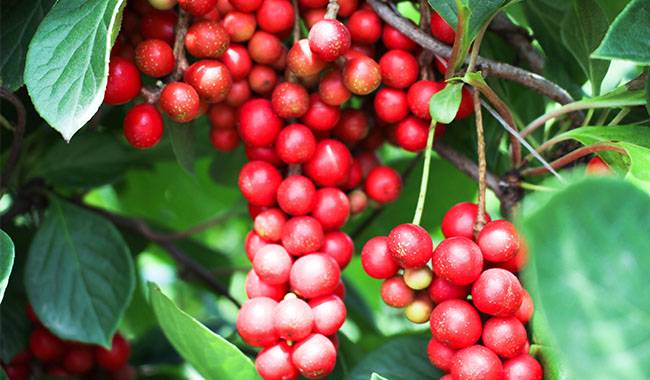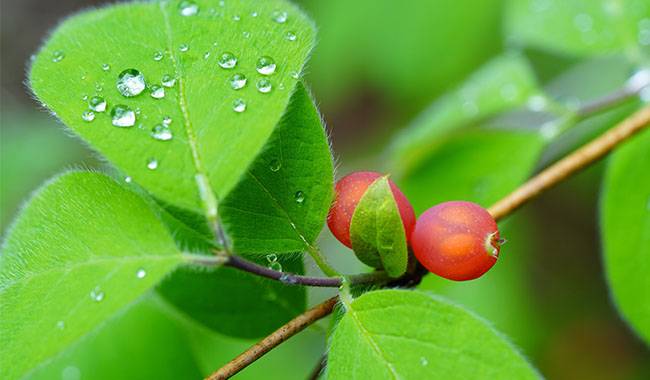
Schisandra Chinensis is easily grown as an ornamental vine by densely covering some unsightly things with its branches. Since it grows wildly, its shoots and leaves can be cut off and put to good use.
When the berries are ripe, use them to make very useful blanks. You can leave some of the berries on the branches over the winter and then head for the Schisandra and gradually collect them.
Anyway, the Chinese schizandra is one of the wonders of the Chinese-American region. Unbelievably beautiful and useful plant. Why? I will tell you in the article.
SCHISANDRA CHINENSIS FOR THE SOUL
At first, the appearance of Schisandra Chinensis surprised me because it appeared late in the forest, when most of the leaves had already flown off and the remaining ones were caught by the first frosts, and bunches of scarlet juicy fruits hung down from the branches of various trees and shrubs.
I have to say that autumn in California is not only beautiful but breathtakingly beautiful and impassioned! Generally, September is warm, dry, and sunny. in September, the salmon are going to spawn – the fish are salted in barrels and frozen in separate freezers.
The forest is full of mushrooms: they have to be dried, salted, pickled, and frozen again. Kiwis (the local quiche) ripen in the woods, and then there will be Vitis amurensis, gochujang, oxalis, and cranberries. And all this against a backdrop of crimson and gold foliage.
If Vitis amurensis is a healthy vine that is impossible not to notice, the stems of the Schisandra are something like “wires” that are tightly wrapped around the trunk and branches of a tree or shrub that happens to be nearby. And these “wires” have berries hanging from them.
Of course, I have planted poinsettias in my backyard. In the shade, because it is used to spending time under the canopy at the beginning of its life, and the bright sunlight will be the object of its yearning. In a dry place, because the wet ones are busy. The gochujang takes it philosophically and begins to occupy the space given to it. In all directions.
Some shoots weave into the support, some shoots germinate and cling to the support, and shoots germinate around and weave on the nearby raspberries. From the raspberries and supports, they climbed up to the branches of the poplar trees leaning against the fence.
So, 5 years later, a natural pergola was formed around the fence – the gochujang was 60inch (1.5m) away from it. The main thing is – the gochujang was exposed to the sun.
All this time, I have not regulated his growth in any way, just pruned the shoots that crept onto the path. His foliage is very good!
The flowers, which appeared only in the fourth year, are beautiful and fragrant, but they are hard to find and identify among the leaves and shoots. However, bees find and drag out nectar and pollen from the poinsettia flowers. By the way, it is a good honeydew.
Schisandra densely weaves any support, forming a whole “mop” of shoots with cheerfully colored leaves. Beautiful autumn is here: the leaves turn first lime red, then lemon red, and in this lemon, bunches of red berries glisten!
For this beauty, I can forgive it for trying to spread and disorderly in different directions (the shoots intertwine and weave everything together, making it impossible to understand them).
A huge pile of shoots grows – we don’t need so many berries, most of them are left for the winter birds. And the hands don’t get up and cut off the excess.
SCHISANDRA FOR THE BODY
Schizandra can have berries, twigs, and leaves for food. The shoots are tart to eat and have a bright lemon and needle scent – I sneak up on the gochujang in the winter and chop the shoots up for tea.
This can also be done from the fall – cut the shoots and dry them, but I like the fresh twigs. Schisandra tea is good on its own, or as an accompaniment to green tea, for example.
The leaves can also be dried and added to the tea – there are essential oils in the leaves as well. Even the stalks have essential oils, so there is no waste.
The berries of Schisandra are sour, so use sugar or honey exclusively. Also good for tea throw or refreshing healing drinks from frozen ground sweetened Schisandra.
Adding more Schisandra juice, such as that of Vitis amurensis, to the wine preparation gives the wine an amazingly subtle lemon hue.
THERAPEUTIC PROPERTIES OF SCHISANDRA CHINENSIS

Schisandra has many medicinal properties. The local population uses it for two main purposes: first, as a powerful adaptogen or tonic, and second, as a blood pressure regulator.
It is a regulator because the pulp and rind of the berries increase pressure, but the seeds in moderate amounts decrease it. My colleague – a hypertensive person – chews the seeds regularly and my hypertensive friend is eating the ground pulp with honey.
Magnolia vine is so adaptogenic and stimulating that it has been second only to ginseng in Chinese medicine since ancient times, and not without reason.
Schisandra chinensis stimulates the nervous system (used at night, only for those who have to be actively awake), increases the photosensitivity of vision (the ability to see better in the dark, at dusk, and in general low light), accelerates the reaction and allows to work longer without fatigue.
This wonderful “acidic” berry regulates the acidity of gastric juice and is used to treat many gastrointestinal disorders.
It’s great in a bath with Schisandra! Take 100 grams of shoots, leaves, and stems, brew them, and pour them into the bath. Your body will thank you. And then there is the smell, which you can enjoy in the bath – there are many essential oils from all parts of Schisandra. You can brew the berries and throw them away – the water will have a nice pink color and the organic acids help to cleanse the skin better.
Since Schisandra is a wonderful stimulant, it is also exceptionally good for intimacy (there’s a reason the Chinese have so many!).
And that’s just the beginning: Schisandra is in demand in gerontology because it supports not only the physiological functions of the aging organism but also the functions of the brain.
According to Chinese history, long-lived emperors never used Schisandra in their diets. Wisely, they began taxing Schisandra berries three thousand years ago.
CHEMICAL COMPOSITION OF THE PLANT
The composition of Schisandra itself is now quite well studied. It contains diterpenoids and their derivatives, steroids, higher fatty acids, and their derivatives, and lignans. The juice of Schisandra contains large amounts of malic acid, citric acid, tartaric acid, sugars, pectin, tannins, coloring substances, vitamin C and P-vitamin active substances.
The berry skin contains tocopherols, sterols, and other bioactive substances. The main amount of schisanin (from the generic name of Schisandra Chinensis) is concentrated here.
The whole plant contains essential oil. In the bark, its content is up to 3.14%. Vitamin E (0.03%), lignin and fatty oils (up to 33.8%), and resins were found in the seeds. The ash contains trace elements such as iron, manganese, silicon, phosphorus, calcium, and copper. At the same time, molybdenum and cadmium hardly accumulate in the fruit, which is typical of areas with harsh ecological conditions.
The fatty oil of Schisandra Chinensis seeds is golden yellow in color and has a characteristic resinous odor and taste, bitter. more than 90% consists of glycerides of unsaturated fatty acids (oleic, α and β-linolenic). It is obtained by CO2 extraction. Understandably, it is very expensive and often adulterated.
The leaves contain five times more vitamin C than the fruit (up to 130 mg%). Therefore, hunters in the taiga region use Schisandra not only as a tonic but also as an anti-pinching agent.
In addition, the leaves accumulate manganese, molybdenum, and especially selenium, so the tea in the leaves is useful for preventing cardiovascular diseases. However, at the same time, they do not raise stress as much as the fruit.
That said, studies have shown that this plant is rich in useful elemental components. After having once discovered schizandra as the main active substance, science and production focused on schizandra. It was Schizandrin that began to be diligently isolated, purified, added to dietary supplements, and used as a medicine for the regulation of the nervous system.
All other elements and compounds accumulated by plants were set aside. To me, this is similar to the agronomic approach to plant nutrition: separating the nitrogen from the manure and throwing out the most abundant minerals, bacteria, microbes, and even balanced biochemical complexes.
Fortunately, you can easily grow Schisandra on your plot and always have this valuable raw material on hand.
Dear Reader It’s no exaggeration: Schisandra warms the soul, is pleasing to the eye, and helps keep the brain and body healthy and vibrant over time. Plant it in your plot and you won’t regret it!



